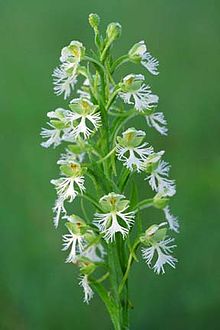Platanthera leucophaea, commonly known as the prairie white fringed orchid[6] or eastern prairie fringed orchid, is a rare species of orchid native to North America. It is a federally threatened species,[7] protected since October 30, 1989 under the Endangered Species Act of 1973.[8] In Canada, it has been listed endangered under Schedule 1 of the Species at Risk Act since 2005.[9] In 2014, the International Union for Conservation of Nature assessed it as "least concern."[1]
| Eastern prairie fringed orchid | |
|---|---|

| |
| Scientific classification | |
| Kingdom: | Plantae |
| Clade: | Tracheophytes |
| Clade: | Angiosperms |
| Clade: | Monocots |
| Order: | Asparagales |
| Family: | Orchidaceae |
| Subfamily: | Orchidoideae |
| Genus: | Platanthera |
| Species: | P. leucophaea
|
| Binomial name | |
| Platanthera leucophaea | |
| Synonyms[4][5] | |
Distribution
editPlatanthera leucophaea is found in moist to wet tallgrass prairie, sedge meadows, fens, and old fields. For optimum growth, little or no woody encroachment should be near the habitat. Historically, the eastern prairie fringed orchid is found primarily in the Great Lakes Region with isolated populations in Maine, Virginia, Iowa, and Missouri. A historic record exists for Choctaw County, Oklahoma. The plant has not been observed in Oklahoma in the past 150 years. The major factor in the decline of the eastern prairie fringed orchid has been a loss of habitat due to grazing, fire suppression, and agricultural conversion.
Description
editPlatanthera leucophaea arises from a fleshy tuber. The plant can grow up to three feet (91 cm) tall. The leaves are long and thin.[10]
The inflorescence is large and showy and may have up to 40 white flowers. It is distinguished from Platanthera praeclara, the western prairie fringed orchid, by its smaller flowers (less than one inch (2.5 cm) long), more oval petals, and a shorter nectar spur.[10]
The eastern prairie fringed orchid is a long-lived perennial. Its tuberous rootstalk helps it survive grass fires. Fires and rain stimulate the plant to grow and flower. The plant emerges each year in May and flowering begins by late June. The flowers are pollinated at night by large sphinx moths. Certain night-flying insects that are attracted to the orchid's fragrance are able to obtain its nectar with their long probosces. Others cannot because of the flower's long, narrow, oddly positioned nectar spur.[10]
References
edit- ^ a b Treher, A.; Sharma, J.; Frances, A.; Poff, K. (2015). "Platanthera leucophaea". IUCN Red List of Threatened Species. 2015: e.T64176760A64176769. doi:10.2305/IUCN.UK.2015-4.RLTS.T64176760A64176769.en. Retrieved 27 April 2023.
- ^ NatureServe (7 April 2023). "Platanthera leucophaea". NatureServe Network Biodiversity Location Data accessed through NatureServe Explorer. Arlington, Virginia: NatureServe. Retrieved 27 April 2023.
- ^ Nuttall, Thomas 1835. Transactions of the American Philosophical Society, new series 5(6[2]): 161
- ^ The Plant List Platanthera leucophaea (Nutt.) Lindl.
- ^ Tropicos, Orchis leucophaea Nutt.
- ^ NRCS. "Platanthera leucophaea". PLANTS Database. United States Department of Agriculture (USDA). Retrieved 7 October 2015.
- ^ "Eastern prairie fringed orchid (Platanthera leucophaea)". Environmental Conservation Online System. U.S. Fish & Wildlife Service. Retrieved 27 April 2023.
- ^ 54 FR 39857
- ^ "Eastern Prairie Fringed Orchid (Platanthera leucophaea)". Species at risk public registry. Government of Canada. 2 February 2021. Retrieved 27 April 2023.
- ^ a b c Flora of North America: Platanthera leucophaea
External links
edit- Media related to Platanthera leucophaea at Wikimedia Commons
- Data related to Platanthera leucophaea at Wikispecies
- photo of herbarium specimen at Missouri Botanical Garden, collected in Missouri in 1933

